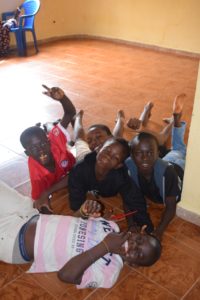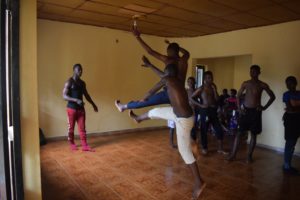 During my second week with MindLeaps in Conakry, the dance program began – and with it came a full-on plunge into new and diverse avenues of this learning experience! I am learning about both Guinean culture and society, and the capacity of dance to empower!
During my second week with MindLeaps in Conakry, the dance program began – and with it came a full-on plunge into new and diverse avenues of this learning experience! I am learning about both Guinean culture and society, and the capacity of dance to empower!
On the first day of dance classes, I began the second half of my research project for this stay in Conakry: testing the appropriateness of an intake questionnaire developed to capture the circumstances and stories of kids who come into the Guinean MindLeaps program.
The questions we had originally put on this questionnaire were backed by fairly extensive research – including all of the work that has gone into similar documents in MindLeaps’ Rwanda projects, as well as a recent search of the limited but fascinating peer-reviewed literature available on youth and vulnerability in Guinea/West Africa, with the aim of adapting the Rwanda questionnaire to the specific Guinea context. And yet, even with all of this research behind us, I was really surprised and intrigued to see just how many challenges, questions, emotions and new ideas emerged from trying this questionnaire out with real kids: the living, breathing embodiments of the culture and society I had so far really only read about!
Firstly, there was difficulty with the understanding and interpretation of certain questions, which meant that a group of 11 kids could all hear the same question and answer it in really different ways. This variety of interpretations, although interesting, hindered our ability to capture a consistent set of variables about each child that could be compiled and compared throughout their group. Part of this can be attributed, I have realized, to the fact that Guinea is an exceptionally multilingual society – with most kids speaking at least three different local languages, as well as French. The linguistics and phrasing of each question, therefore, needs to be really carefully thought out and tested across all of the languages, and with various translators, to ensure that the meaning stays the same and makes sense within the cultural context. The cultural overlay that impacts how this questionnaire works certainly affects understanding and interpretation, but also significantly impacts appropriateness and comfort levels. Certain subjects were very embarrassing or emotionally painful for children to talk about in this initial testing, and we want to eliminate this discomfort as much as possible. In doing so, we hope to make children feel safe and respected in MindLeaps and open to discussing their unique circumstances. All in all, the process of testing and adapting this intake questionnaire is a wonderful and ongoing learning experience for me about how to develop a research tool that can accurately and sensitively capture circumstances in a cultural environment I don’t yet fully understand.
Beyond learning about research methods, however, this process also gave me a priceless opportunity to learn about the kids themselves. In a cultural sense, I have learned a lot about the practice of polygamy in Guinea and how this affects family structure and children growing up/attending school. In a societal and historical sense, I have seen glimpses – through these children’s stories – of how the acting government influences the living situations of vulnerable populations and the impact this has on the lives of children who may be forced to leave their homes or are “cleaned up” from the streets into compounds. I’ve heard about the most heartbreaking parts of these children’s life stories – from abandonment by parents to the death of parents to the reality of begging on the streets and not being able to predict the next meal.
I have asked kids, “Who takes care of you when you are sick?”
I have been totally devastated to hear the answer, “I don’t know.”
Juxtaposed in the very same interview, I have been extremely heartened to hear a child, when asked about her hope for the future, tell me that nothing will stand between her becoming a doctor, a pilot, an architect, or a footballer. It has been the most amazing and intimate chance to get to know this special cohort of children, and I know that it is affecting me in all sorts of ways as I grow and learn through the process.
Throughout this, when learning more and more about the kids and where they have come from, the question that sometimes comes to mind is, “Why Dance?” Why, when these kids need so many of the basics – food, clothing, shelter, support – is giving them the opportunity to learn through dance the right and the best thing to do? Well, I can confirm from this week of experiences that all it takes is one MindLeaps dance class to answer this question in full; and this is one reason I’m really glad that we are conducting the intake questionnaires with the program ongoing.
Taking absolutely every chance I can get to watch the kids move or – better yet – dance beside them, I am able to see how the seven cognitive and non-cognitive skills woven into the MindLeaps curriculum can be markedly and visibly improved even in a single class, giving these kids attributes and attitudes that will last much longer than a single meal. When learning how to follow through in a dance class to work past the hard warm up and get into the fun combinations, the kids are developing – before my very eyes – determination and focus that I can so easily imagine being translated into other parts of life and meaningful future endeavors.
In watching children learn, perform and celebrate pieces of choreography, I witness them increase their capacity for memorization and retention. Further, I watch them gain confidence in their abilities and develop a willingness to express themselves and perform – life skills that will encourage them to believe they are worthy of achieving and succeeding in the future based on their own merit. More than anything, however, I am consistently privy to the most beautiful and tangible joy and camaraderie amongst the students, and a building of trust and community that is invaluable and nurturing beyond any physical gift that could be given to these children.
The appropriateness of the dance program to the circumstances of these children is probably best exemplified in how willing they are to overcome obstacles and show up absolutely every day – many of them walking 1.5 hours through the city. Knowing full well from other parts of the intake questionnaire about their financial and family situations, I am often astounded to ask them, “What barriers could prevent you from participating in this program?” and have them answer with “Nothing.”
They want to be here, to be affirmed in their worth in an atmosphere of learning, expression and growth – and I simply cannot wait to see what they will achieve through dance in the time that I am here!
Julia Sawatzky, originally from Edmonton, Canada, is a medical student at the University of St. Andrews in Scotland. She is volunteering with MindLeaps Guinea in June-July 2017 as part of a university scholarship program.


